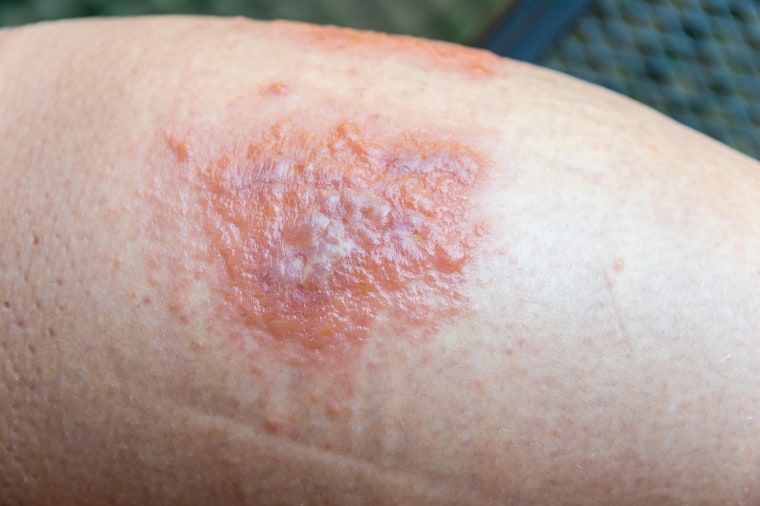7 Signs a Skin Rash Could Indicate Something Serious - TODAY
In the summer months, you might notice your skin turning red and blotchy, or find yourself covered in itchy red bumps and wonder what caused them. These symptoms could be heat rash, sun poisoning, or one of any number of skin conditions.
Rashes when you're spending outside in nice weather are more common, Dr. Carolyn Jacob, a Chicago-based, board-certified dermatologist, tells TODAY.com. They can be caused by the sun, sweating in high temperatures, bites from insects, brushing up against certain plants, or even an allergic reaction to a new body lotion.
In many cases, some over-the-counter ointment will do the trick. Other times, seeing a doctor will help your skin health much faster. But how do you know when to worry about a rash in adults?
Here are some tips to help you identify when your skin rash is a sign of something more serious.
When to seek to medical help
The first thing to look out for is experiencing symptoms in addition to the rash.
While most rashes do not indicate anything fatal, feeling sick in addition should prompt you to see a doctor or other health care professional, Dr. Daniela Kroshinsky, director of inpatient and pediatric dermatology at Massachusetts General Hospital, tells TODAY.com.
That's because rashes can be caused by serious medical problems, especially autoimmune conditions or Lyme disease, Dr. Laura Ferris, professor of dermatology at University of Pittsburgh, tells TODAY.com — although you'll probably find that it was caused something much less serious.
Contact your primary care provider or dermatologist to help you assess if and how quickly you need medical care.
How can you tell if a rash is serious?
Wondering if a health care provider should look at your rash? Here are some potential signs.
1. Fever or pain in addition to a rash.
These could indicate an infection or allergic reaction.
2. Bruise-like marks that spread suddenly.
These are a symptom of vasculitis, when blood vessels become inflamed, which can lead to blood clots, aneurysms or organ damage, according to Mayo Clinic.
3. The rash does not become less severe with time.
You might have an infection, Kroshinsky said. "Some rashes start out completely benign, but then a secondary infection develops because the integrity of the skin, which is a barrier against potential pathogens, has been disrupted." Other signs of infection include warmth, pain, yellow or green cloudy discharge and a bad odor.
4. The rash is widespread.
It can be a sign of a major allergic reaction. "For example, if this happens within two weeks of starting a new medication, the concern would be a reaction to the medication," Ferris said.
5. The rash starts to blister.
This should send you straight to the doctor's office, unless you have good reason to suspect you've come in contact with poison ivy, the experts say.

6. Purple spots on your hands and feet.
These could be a sign of a bacterial infection of the heart, Kroshinsky said.
7. A circular-shaped rash in an area where Lyme disease is endemic.
This could be a sign that you've been bitten by a tick carrying Lyme disease. Many people are not aware that there is Lyme disease where they live. The Centers for Disease Control and Prevention have a map tracking where cases of Lyme disease have been reported in the U.S.

If you're not ready to see your doctor, Kroshinsky suggests taking a photo of your rash.
"It can be helpful when you come in to see us since the rash could have changed by then," she explains. "This will tell us what it looked like before you started treating it with bacitracin or hydrocortisone. It will help us get a sense of the evolution of the rash."
Treatments to avoid making a rash worse
Keep in mind that certain treatments for your skin condition might make things, Kroshinsky advises.
"If you're using a preparation with topical antibiotics, a significant number of people are allergic to bacitracin and neomycin," she says. "If the area you are treating becomes itchy or blistery, you might want to stop using them and see a doctor."
And if you feel unsure about a rash, don't hesitate to seek medical advice from a dermatologist, Ferris says.
"We're trained to distinguish between concerning and non-concerning rashes and getting you on the appropriate treatment," she adds.
Comments
Post a Comment